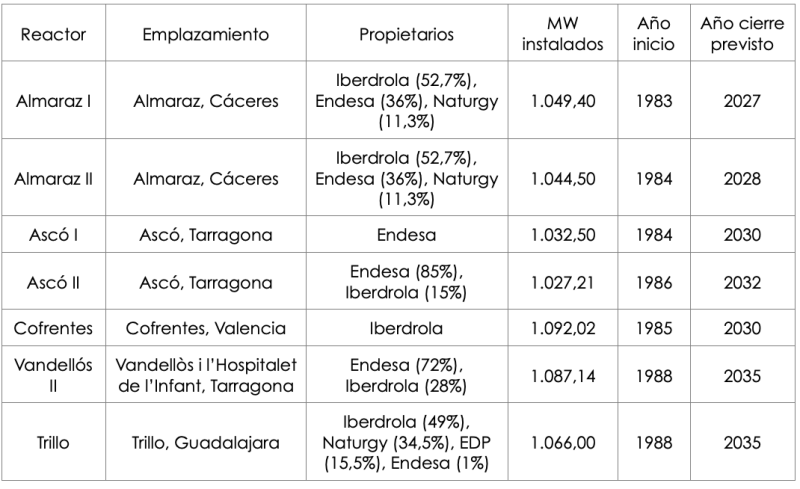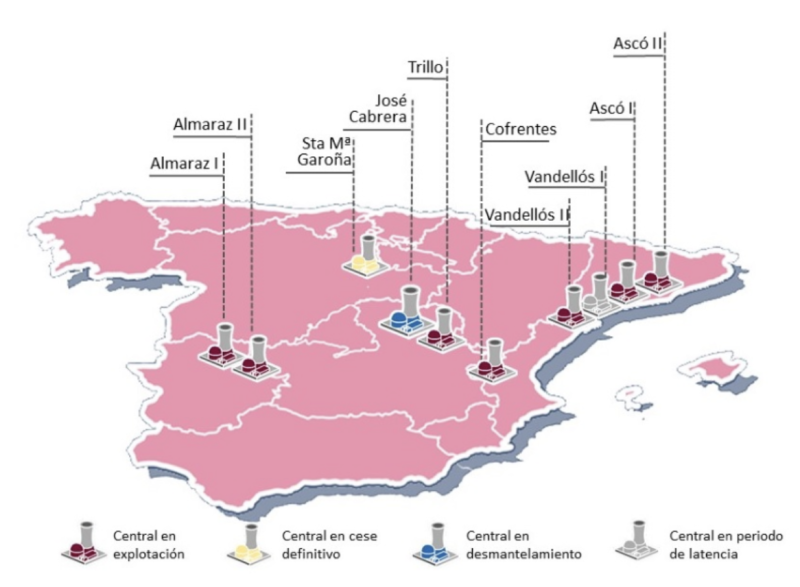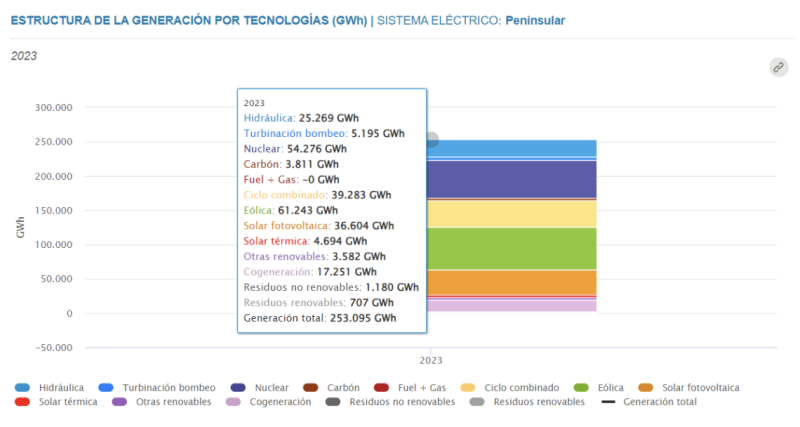
Like all countries, Spain is facing a path towards energy transition, driven by global agreements such as the Paris 2015 agreement and European roadmaps that are transposed to the national roadmap embodied in the PNIEC (PNIEC…2.0). Fossil generation technologies are being replaced, such as coal, and targets are set to gradually reduce those that emit CO2. In some countries, such as Spain, a roadmap has also been set for nuclear power plants, because although they do not emit greenhouse gases, they do generate radioactive waste that is difficult to manage.
The Spanish nuclear fleet currently consists of 5 nuclear power plants spread throughout Spain, two of which have two reactors each, Almaraz and Ascó. Therefore, the Spanish energy mix has 7 reactors with an installed electrical power of 7,398.77 MW. The PNIEC 2021-2030 details a timetable for the closure of all reactors between 2027 and 2035:


Image 1: Geographical location of nuclear power plants in Spain
Source: Ministerio para la Transición Ecológica y el Reto Demográfico
Current contribution to the energy mix
We have seen that nuclear contributes 7.4 GW of stable power to the electricity system, beyond scheduled outages for refueling or occasional emergency outages. This stable generation covers practically 90% of the hours of the year, and represents 20% of the electricity consumed, with a generation of 54,276 GWh in 2023, representing 5.71% of the total installed power. The reduction in CO2 emissions that this represents is approximately 20 million tonnes per year.

Image 2: Generation by technology in 2023
Source: Red Eléctrica
These numbers alone would undoubtedly provide a view in favour of extending the useful life of reactors, as they support the three pillars of an electricity system: stable security of supply, competitive prices on the wholesale market and energy independence.
However, this was not enough for the government to condemn nuclear power in the PNIEC, as it opted for renewable energies and doubts about their safety weighed against nuclear power, which had been called into question in well-known cases such as Chernobyl in 1986, Fukushima in 2011 and the risks posed by the war at the Zaporiyia plant, which once again brought the debate about the risk of nuclear power to the forefront. If we add the difficult management of radioactive waste, the approaching end of the 40-year lifespan of the reactors and the constant social pressure from part of civil society, it sentenced nuclear power in Spain, as it has also done in Germany.
However, a last life for nuclear power is always on the cards, as the umpteenth battle between the government and the nuclear lobby, made up of the country’s big electricity companies, owners of the nuclear power plants, is currently boiling over. In the agreed closure, the protocol included an increase in the useful life of the reactors to an average of 46 years, in exchange for increasing the fee that the plant owners must pay for the management of radioactive waste to the public company in charge Enresa (the so-called Enresa Fee) to 7.98 €/MWh. The recent revision by the government to raise the Enresa tax by more than 40%, to 11.14 €/MWh, has put those affected on the warpath. This increase makes plant operations more expensive, and even threatens scheduled closures. For example, at Trillo, which will be one of the last to close, in 2035, this increase will have a major impact on its last 10 years of operation, which could lead the licensees to decide to bring forward the closure, arguing that this rate increase was not foreseen and therefore alter the planned energy transition plans. And this negotiation may also alter the first to close, Almaraz I, which is scheduled to close in October-November 2027. This date implies that the management of the closure to be processed by the Nuclear Safety Council (CSN) in November of this year may be affected by the negotiations being carried out by the government and the electricity utilities.
Future without nuclear
As with any issue, the nuclear dilemma does not escape the polarisation of society. Environmentalists have been denouncing the risks of nuclear power for years, while others argue that it provides technological know-how and skilled jobs, arguing that other countries such as France are committed to nuclear energy. Even in politics it has been the subject of debate, between parties that advocate extending the useful life of nuclear power and those that advocate its continued closure.
Aleix Pujols | Operations Head
If you found it interesting, please share it!
Recent Articles
















